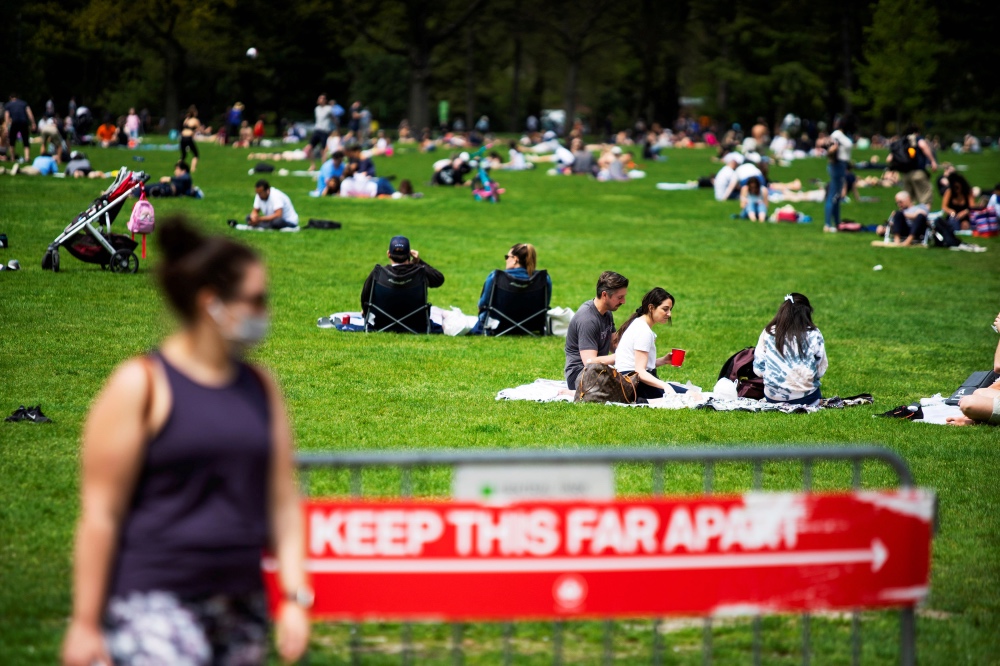Washington DC, US
Thomson Reuters Foundation
First pandemic, now social unrest – parks are in peak demand, but their new popularity has revealed an unfair distribution of public space in US cities, with minorities often shut out.
Months of lockdown under COVID-19 and weeks of protest have sparked an unprecedented use of US parks and public spaces, and prompted fresh debate about how cities should allot space or refashion busy streets and sidewalks into new shared places.

People rest and enjoy the day at Central Park maintaining social distancing norms, during the outbreak of the coronavirus disease (COVID-19) in the Manhattan borough of New York City, US, on 2nd May. PICTURE: Reuters/Eduardo Munoz
“We are seeing the role that public space plays multiply,” said Nette Compton, a deputy director at the Trust for Public Land, an NGO.
“The intensity of use for public protest…is an additional level on top of the demand for parks and public space in the midst of the coronavirus.”
This dual demand is exacerbating inequities that have long existed, she told the Thomson Reuters Foundation, with many poor and vulnerable people cut off from fresh air and green spaces.
“So communities that don’t have access to a robust, well-maintained park system are suffering.”
Researchers with the Brookings Institution think tank last year found that of the country’s 100 largest metro areas, communities with higher poverty rates tended to have lower park access.
About a third of Americans do not have a park within a 10 minute walk of home, according to the Trust for Public Land, despite research showing access to green space carries multiple health benefits.
Much of this pattern is linked to racist investment policies in the past, Compton said, pointing in particular to a practice of “redlining”, in which banks and policymakers purposefully limited financial resources in minority communities.
Yet this fact is also increasingly being recognized and used to guide the next phase of planning, she said.
Other research has found that even today, a wider racism in society keeps many African Americans out of parks even if they were close by, with some suggesting they do not feel these areas are for them, that they do not belong, or feel unsafe.
“We live in a culture of systemic racism, and that doesn’t stop when you enter a park, unfortunately,” Compton said.
Third phase
After the coronavirus outbreak was declared a pandemic in March, US public space was almost completely empty for a few weeks, said Phil Myrick, who heads the Project for Public Spaces, a non-profit.
But that was followed by a rise in the use of parks, trails and other areas to levels that Myrick had never seen before as locked-down citizens sought new outlets.
“Now we’re in this interesting third phase, in which city leaders and others are very concerned to make sure we have an equitable approach to public space, and stretching those outdoor opportunities to the rest of us,” he said.
Building new parks is often not an option, particularly in the short term – but repurposing existing parts of the city might well be.
Myrick says cities big and small can create new open spaces or places for recreation simply by closing streets to vehicles, expanding sidewalks and allowing businesses to expand outdoors.
“It turns out those opportunities are all around us,” he said.
Biggest need
But opening streets to walkers and cyclists is not always viable in dense urban areas, even if the need may be greatest.
Poor and vulnerable communities are often “transport deserts”, said Michael Berkowitz, founder of the Resilient Cities Catalyst non-profit, making it hard for policymakers to open streets in those neighbourhoods.
“But the irony is that those neighborhoods need it the most,” he said, “because they have the least access to parks, and they have the least greenery.”
Public space is also for more than exercise, Berkowitz noted, as has become clear in the racial equality protests.
“Giving rightfully aggrieved people places to express their freedom of speech and participate in a democracy is another super critical role” of public space, he said.
“You could see needing more public space for not just the next couple of weeks but for the next couple of years.”






